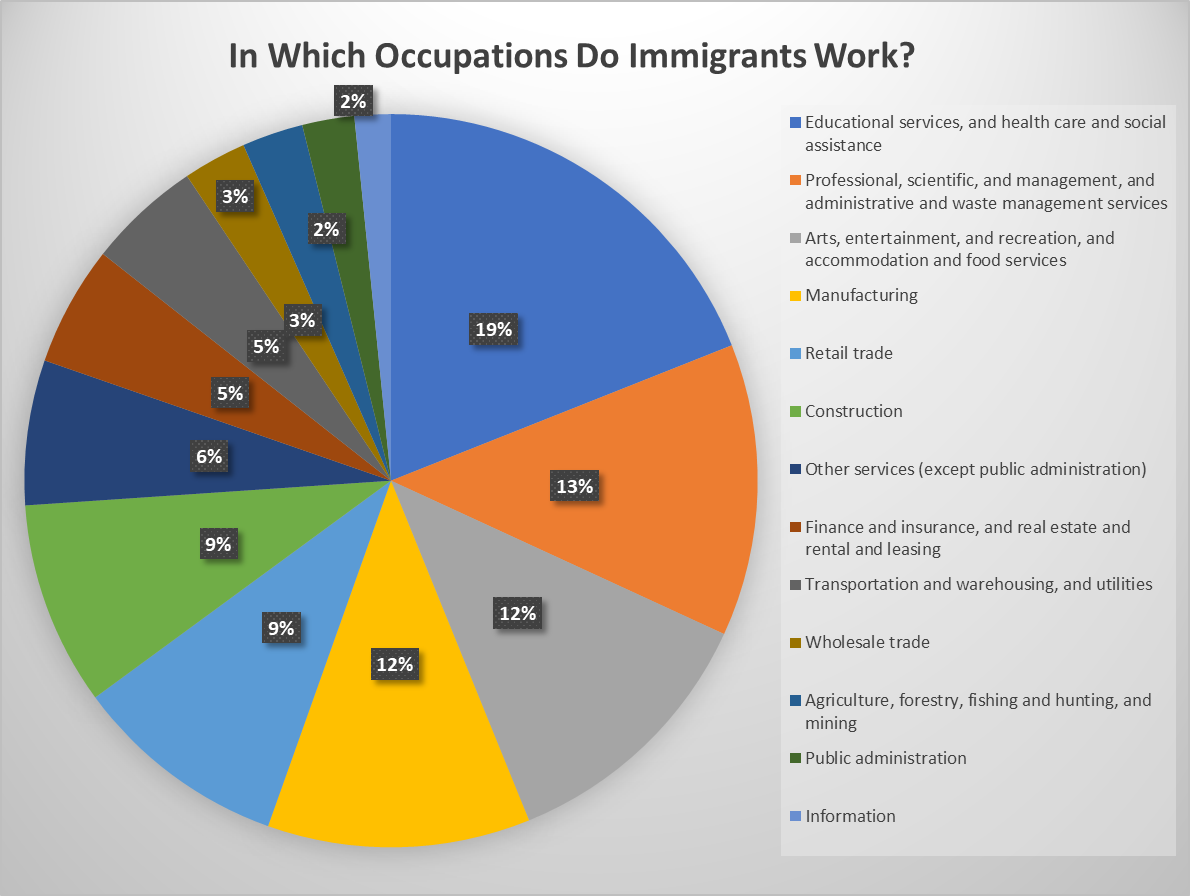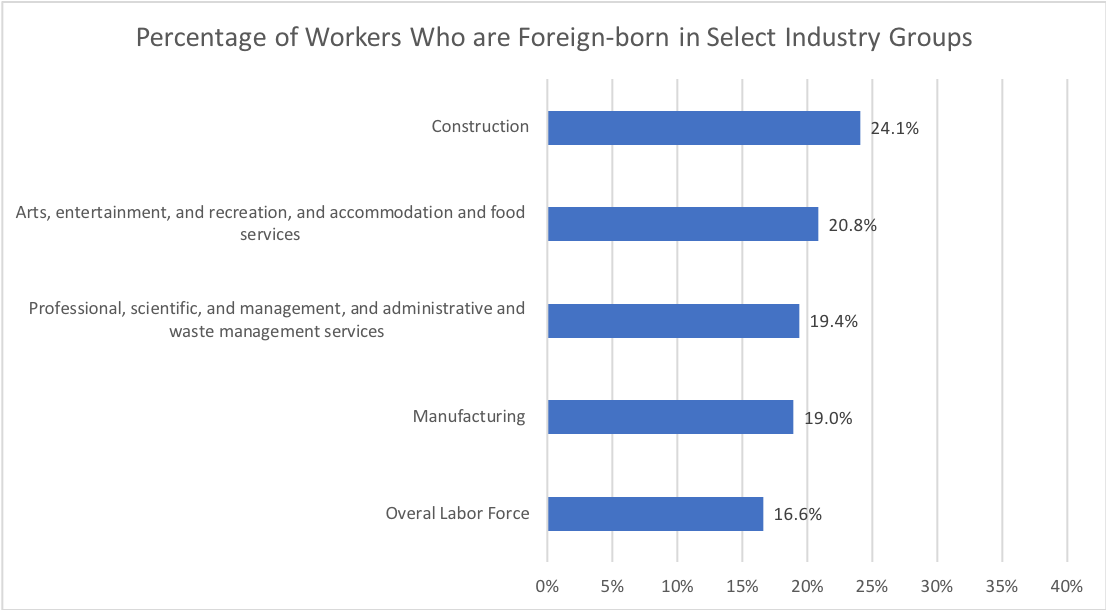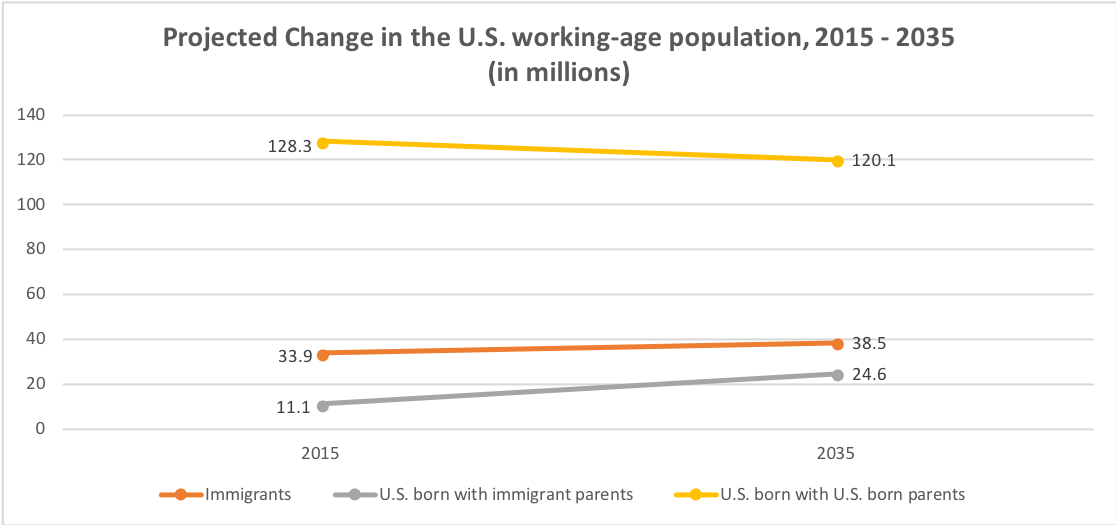Immigrants today play a crucial role in the U.S. workforce. Although 17 percent of the overall workforce is foreign-born, certain industries are much more dependent on immigrants.
Nearly one quarter of workers in the construction industry are immigrants, for example. About a third of immigrant workers do not have authorization to work legally in the U.S., and these immigrants are also vital to the American economy. As it grows, the number of jobs will expand at all skill levels.
Immigration policies should facilitate finding workers willing and able to fill jobs requiring lower skill levels, not make it harder. As important as immigrants are to today’s U.S. workforce, they will be more vital in the future. Between now and 2035, all growth in the U.S. workforce will be entirely due to immigrants and their children.
This fact sheet, one of a seven-part series, highlights research showing the critical role of immigrants in our workforce and economy.
Immigrants and the American workforce
According to the Census Bureau, there are 161 million workers in the American workforce. Nearly a quarter of our workforce, 23.1 percent, is employed in “educational services, health care and social assistance.” About 11.5 percent of workers are employed in the retail trade while another 11.2 percent work in professional, scientific, management, administration and waste management services. The manufacturing sector employs 10.3 percent of U.S. workers.
Immigrants make up approximately 17 percent of the U.S. labor force, about one in six workers. More than half of immigrant workers in the U.S. (56 percent) work in just four major industry groupings:
- Educational services, health care, and social assistance.
- Professional, scientific, management, administrative, and waste management services.
- Arts, entertainment, recreation, accommodation, and food services.
- Manufacturing. *
[*] These are the groupings of industries used by the Census Bureau.
The following chart shows how immigrant workers are distributed among various industries.

Source: U.S. Census Bureau
If we focus on the makeup of the workers in different industries, however, we can see that certain industries are very reliant on immigrant labor. While only 9 percent of immigrants work in construction, immigrants make up nearly a quarter (24.1 percent) of the construction workforce. Other examples are represented in the graph below.

Source: U.S. Census Bureau
Immigrants tend to participate in the labor force at higher rates than U.S.-born workers. The overall labor force participation rate for immigrants is 65.2 percent, slightly higher than the 62.3 percent rate for those born in the U.S. The immigrant labor participation rate for men is 77.8 percent, 10 points higher than the percentage of U.S.-born men in the labor force (67.5 percent).
Unauthorized immigrants also contribute to our economy
Seventeen percent of the U.S. workforce are immigrants among whom estimates indicate that nearly one-third do not have authorization to work legally. In other words, undocumented workers make up about 5 percent of the workforce. They are not distributed evenly among all industries. For example, according to a report by the Department of Labor based on a survey of agricultural workers in 2013-2014, nearly half (47 percent) of farmworkers had no work authorization. Other estimates based on 2014 census data show that undocumented immigrants make up 12.7 percent of the construction workforce, 8.7 percent of the leisure and hospitality workforce, and 6.2 percent of all business service workers.
Examining the status of workers in more detailed occupational categories better illustrates the fact that undocumented workers are a crucial component of many occupations. The graph below highlights some of the occupations where undocumented immigrants are estimated to make up a significant percentage of workers.

Source: Pew Research Center
Our future workforce will require workers at all skill levels
In discussions of the future of the American workforce, the focus tends to be on the increasing amount of education and skills that American workers will need. We lose sight of the fact that our economy will need workers at all skill levels. Between 2014 and 2024, eight of the top 15 job categories that will see the greatest growth will require no formal educational credentials. Jobs such as personal care aides, home health aides, food preparation workers, retail salespersons, cooks, construction laborers, janitors, and material movers are expected to increase by 2,032,000 in the 10-year period from 17,537,000 jobs to 19,569,000 jobs, representing 21 percent of all new jobs.
As U.S.-born workers become more educated, they will be less inclined to look for low-skill jobs requiring a high school education or less. Similarly, an immigration system that is skewed toward accepting immigrants with high levels of education and skills (a bachelor’s degree or greater) will turn away workers who could fill jobs that require less education and training, but who are, nevertheless, crucial. The chart below shows the skill level and educational requirements for the occupations that are projected to demand the greatest number of new workers between now and 2024.
| Occupations with the most projected job growth, 2014-2024 | |||||
| Occupation | New jobs 2014 – 2024 | Percent change | Median annual wage | Skill level and typical educational credential | |
| Home health aides | 348,400 | 38.1% | $21,380 | “Low skill” – no formal educational credential | |
| Personal care aides | 458,100 | 25.9% | $20,440 | “Low skill” – no formal educational credential | |
| Medical assistants | 138,900 | 23.5% | $29,960 | “Middle skill” – postsecondary nondegree award | |
| Software developers, applications | 135,300 | 18.8% | $95,510 | “High skill” – Bachelor’s degree | |
| Nursing assistants | 262,000 | 17.6% | $25,100 | “Middle skill” – postsecondary nondegree award | |
| Registered nurses | 439,300 | 16.0% | $66,640 | “High skill” – Bachelor’s degree | |
| Cooks, restaurant | 158,900 | 14.3% | $22,490 | “Low skill” – no formal educational credential | |
| Construction laborers | 147,400 | 12.7% | $31,090 | “Low skill” – no formal educational credential | |
| Combined food preparation and serving workers, including fast food | 343,500 | 10.9% | $18,410 | “Low skill” – no formal educational credential | |
| Accountants and auditors | 142,400 | 10.7% | $65,940 | “High skill” – Bachelor’s degree | |
| Customer service representatives | 252,900 | 9.8% | $31,200 | “Low skill” -high school diploma or equivalent | |
| General and operations managers | 151,100 | 7.1% | $97,270 | “High skill” – Bachelor’s degree | |
| Retail salespersons | 314,200 | 6.8% | $21,390 | “Low skill” – no formal educational credential | |
| Janitors and cleaners, except maids and housekeeping cleaners | 136,300 | 5.8% | $22,840 | “Low skill” – no formal educational credential | |
| Laborers and freight, stock, and material movers, hand | 125,100 | 5.1% | $24,430 | “Low skill” – no formal educational credential | |
Source: U.S. Department of Labor
In addition to growing worker shortages in lower-skilled occupations, a combination of factors will exacerbate worker shortages in middle-skills occupations (requiring a postsecondary education or training but with less than a four-year degree). According to the National Skills Coalition, more than 50 percent of jobs are currently in the middle-skills level, and they will represent the largest percentage of job openings overall through 2024.
Immigrants and their children will drive the growth in the U.S. workforce
According to the latest population projections by the U.S. Census Bureau, immigration will become the primary driver of U.S. population growth by 2030, not because of an increase in immigration, but primarily due to the — rising number of deaths and lower birth rates in the U.S.-born population.
Growth in the country’s workforce likewise will be driven by an increase in the number of immigrant workers between now and 2035. As the baby boom generation leaves the workforce, the number of working-age adults born in the United States to U.S.-born parents will decline by 8.2 million. Balancing out this decline will be the growth in the number of working-age immigrants and their children. Without new immigrants, the total population of working-age adults is expected to decline over the next 20 years.

Source: Pew Research Center
The government projects the economy will add 9.8 million jobs between 2014 and 2024, but the labor force will only grow by 7.9 million workers. In other words, the economy will grow faster than the workforce will. However, if more restrictive immigration policies are put in place, this gap between job openings and available workers will grow. If immigration to the United States is reduced, the working-age population will grow more slowly, or not at all. In other words, restricting legal immigration to the U.S. will act as a brake on the economy, slowing its growth.
Conclusion
The research highlighted in this fact sheet demonstrates the importance of immigrants to America’s workforce. Immigrants and their children will become increasingly important to our future workforce because large numbers of baby-boomers are leaving the workforce and there are simply not enough U.S. born workers to fill those openings. Additionally, some of the jobs that require little formal education will be of less interest to an increasingly educated U.S.-born workforce. The research cited in this fact sheet also shows that, as important as immigrants are to today’s workforce, about one third of current immigrant workers are not authorized to work in the U.S. Our ability to meet America’s future workforce needs will depend, in no small part, on ensuring the U.S. has sound immigration policies that meet the economic needs of our nation.
*Special thanks to Maurice Belanger for his contributions to this series.
To see all papers in the Immigrants as Economic Contributors series, click here.
Immigrants as Economic Contributors They Are the New American Workforce PDF
Author: Dan Kosten



